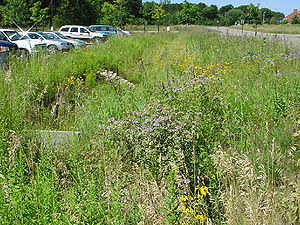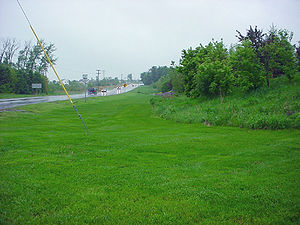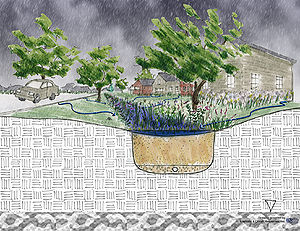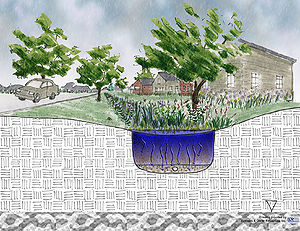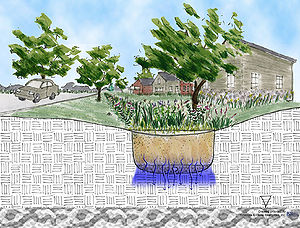
Design criteria for swales Redirect page
Redirect to:
Contents
- 1 Filtration Overview
- 2 Major Design Elements
- 2.1 Physical Feasibility Initial Check
- 2.2 Conveyance
- 2.3 Pre-treatment
- 2.4 Treatment
- 2.5 Landscaping
- 2.6 Safety
- 2.7 Design Procedure: Media Filters
- 2.8 Design Steps
- 2.8.1 Step 2. Confirm design criteria and applicability.
- 2.8.2 Step 3. Select design variant based on Physical Suitability Evaluation
- 2.8.3 Step 4. Compute runoff control volumes
- 2.8.4 Step 5. Compute Vwq peak discharge (Qwq)
- 2.8.5 Step 6. Size flow diversion structure, if needed
- 2.8.6 Step 7. Size filtration basin chamber
- 2.8.7 Step 8. Size sedimentation chamber
- 2.8.8 Step 9. Compute Vmin (minimum volume that can be stored within the filtration chamber)
- 2.8.9 Step 10. Compute storage volumes within entire facility and sedimentation chamber orifice size
- 2.8.10 Step 11. Design inlets, pre-treatment facilities, under-drain system, and outlet structures
- 2.8.11 Step 12. Compute overflow weir sizes
- 2.8.12 Step 13. Check volume, peak discharge rates and period of inundation against State,local and watershed organization requirements (Note: Steps are iterative)
- 2.8.13 Step 14. Prepare Vegetation and Landscaping Plan
- 2.8.14 Step 15. Prepare Operations and Maintenance (O&M) Plan
- 2.8.15 Step 16. Prepare Cost Estimate
Filtration Overview
Filtration practices are structural stormwater controls that capture, temporarily store, and route stormwater runoff through a filter bed to improve water quality.
Design Criteria
- Ensure adequate space for Filtration system
- Some installations require 2-6 feet of head
- Removal potential of the key pollutant
- Parent material and potential for ground water contamination
Benefits
- Good for highly impervious areas with low sediment/high pollutant load (e.g. urban land use and retrofit scenarios)
- High pollutant removal rates
- May be used in a variety of soil types
- Good for the treatment of hotspots because it can be isolated from groundwater if contamination concerns exist Limitations:
- Higher maintenance requirements
- Some installations (media filters) have higher construction costs
- Potential to cause odor problems
- Minimal treatment of soluble nutrients
- Potential for nitrification in media filters where anaerobic conditions exist
Description
Filtration systems vary in their operation and applicability, but all can be described as structural BMPs that function mainly to enhance water quality by passing stormwater through a media. The media can be made of sand, peat, grass, soil, compost or vegetation and should be assigned on a case-by-case basis. Filters can be off-line systems or designed as pre-treatment before discharging to other stormwater features.
The two main categories of filtration systems include: media filters, and vegetated filters. media filters can be located on the surface, underground, along the perimeter or an area, or in what is called a pocket design. Vegetated channels may be grass channels, dry or wet swales, submerged gravel wetlands, or filter strips.
Filtration Practices
STORM SEQUENCE
MANAGEMENT SUITABILITY
- Water Quality (Vwq) = High
- Channel Protection (Vcp) = Med.
- Overbank Flood Protection (Vp10) = Low
- Extreme Flood Protection (Vp100) = Low
- Recharge Volume (Vre) = Med./ Low
MECHANISMS
- Infiltration with appropriate soil & site conditions =
- Screening/ Filtration
- Evaporation
- Transpiration if vegetated
- Soil Adsorption
- Biological/ Micro. Uptake
POLLUTION REMOVAL
70 to 85 percent Total Suspended Solids (TSS)
- 0 to 50 percent/35 percent Nutrients - Total Phosphorus /Total Nitrogen
- 45 to 85 percent Metals - Cadmium, Copper, Lead, and Zinc
- 35 percent Pathogens - Coliform, Streptococci, E. Coli
- 80 percent Toxins - Hydrocarbon
SITE FACTORS
- 5 - AC Max Drainage Area
- 20 percent - Max. Site Slope
- 3 feet - Min. Depth to Bedrock
- 3 feet- Min. Depth to Seasonally high Water Table
- A,B,C,D -NRCS Soil Type
- Poor - Good Freeze/ Thaw Suitability
- Suitable - Potential Hotspot Runoff requires impermeable liner
Major Design Elements
Physical Feasibility Initial Check
Before deciding to use a filtration device for stormwater management, it is helpful to consider several items that bear on the feasibility of using such a device at a given location. The following list of considerations will help in making an initial judgment as to whether or not a filtration device is the appropriate BMP for the site.
Drainage Area: Five acres maximum RECOMMENDED (0.5 to 2 acres is ideal). Surface sand filters can sometimes be sized for drainage areas up to 10 acres, but only with rigorous and committed maintenance schedules, among other design and O&M considerations.
Site Topography and Slopes: It is RECOMMENDED that sloped areas immediately adjacent to practice be less than 20 percent but greater than 1 percent, to promote positive flow towards the practice.
Soils: No restrictions for media filters with under-drain is needed. Vegetated filters should be sized assuming no losses to infiltration.
Depth to Water Table and Bedrock: No minimum separation distance is needed if filter is fully enclosed (i.e., no exfiltration).
Site Location/Minimum Setbacks:
For purposes of this guidance, it is assumed that the definition of a stormwater pond includes a stormwater filtration system.
Karst: It is HIGHLY RECOMMENDED that Uunder-drains and an impermeable liner be used for sand filters in Karst terrain. It is RECOMMENDED that vegetative filters be designed such that concentration of flow and excessive flow depths are avoided.
Conveyance
It is HIGHLY RECOMMENDED that a flow splitter or diversion structure be provided to divert the Vwq to media filters and allow larger flows to bypass the practice. Where a flow splitter is not used, it is HIGHLY RECOMMENDED that contributing drainage areas be limited to approximately 0.5 acres and an overflow be provided within the practice to pass part of the Vwq to a stabilized watercourse or storm drain. It is also HIGHLY RECOMMENDED that overflow associated with the Vp10 or Vp100 storm (depending on local drainage criteria) be controlled such that velocities are non-erosive at the outlet point to prevent downstream slope erosion. Weirs are common overflow systems within media filters. It is HIGHLY RECOMMENDED that the flow splitter be designed such that 75 percent of the Vwq can enter the treatment system prior to flow bypass occurring at the flow splitter. The overflow weir between the sedimentation and filtration chambers may be adjusted to be lower in elevation than the flow splitter weir to minimize bypass of the filter system prior to inflow filling the 75 percent Vwq storage.
It is HIGHLY RECOMMENDED that media filters be equipped with a minimum 8 inches diameter under-drain in a 1 foot gravel bed. Increasing the diameter of the under-drain makes freezing less likely. The porous gravel bed prevents standing water in the system by promoting drainage. Gravel is also less susceptible to frost heaving than finer grained media. It is also HIGHLY RECOMMENDED that a permeable filter fabric be placed between the under-drain and gravel layer but not extend laterally from the pipe more than two feet on either side
Pre-treatment
Dry or wet pre-treatment is REQUIRED prior to media filter treatment pre-treatment volume equivalent to at least 25 percent of the computed Vwq is HIGHLY RECOMMENDED). The typical method is a sedimentation basin with a RECOMMENDED minimum length to width ratio of 2:1. The Camp-Hazen equation is used to compute the target surface area for media filters requiring full sedimentation for pre-treatment (WSDE, 1992).
The RECOMMENDED pre-treatment for vegetative filters is a level spreader that allows coarse sediment to settle and evenly distributes flow across the full width of the filter.
The RECOMMENDED pre-treatment for media / vegetative filters such as dry swales is to install plunge pools where concentrated flows enter and to place level spreaders where lateral flows enter.
Additional pre-treatment measures include filter strips and street / parking lot sweeping. Street / parking lot sweeping may be considered pre-treatment in the case of a parking lot island or other area where spatial limitations make structural pre-treatment measures unfeasible.
When using media filters to treat runoff from potential stormwater hotspots (PSHs), particularly in sensitive watersheds, it is HIGHLY RECOMMENDED that additional practices be incorporated as partial treatment during the winter when the filter bed may be frozen.
Treatment
The following guidelines are applicable to the actual treatment area of a filtration facility:
Space Required: Function of available head at site for surface filters. Underground filters generally have little or no surface space requirements except for access.
Slope: The surface slope of media filters should be level to promote even distribution of flow throughout the practice. It is HIGHLY RECOMMENDED that vegetative filters have a maximum slope of 5 percent and a minimum slope of 1 percent.
Depth: The RECOMMENDED elevation difference at a site from the inflow to the outflow is 4 to 6 feet for most sand filters, and 2 to 3 feet for perimeter filters.
Aesthetics: Vegetative filters can be effectively integrated into the site planning process, and aesthetically designed as attractive green spaces. Media filters are less conducive to site aesthetics, but surface media filters can be designed with turf cover crops if desired.
Landscaping
It is REQUIRED that impervious area construction be completed and pervious areas established with dense and healthy vegetation (see Minnesota plant lists) prior to introduction of stormwater into a filtration practice.
Surface filters can have a grass cover to aid in pollutant adsorption. The grass should be capable of withstanding frequent periods of inundation and drought.
Safety
No building structures should be constructed on top of underground filters.
The risk of creating mosquito breeding areas can be minimized by following the recommendations within the mosquito control section.
It is HIGHLY RECOMMENDED that swale side slopes be set at 1:3 (V:H) or flatter.
It is HIGHLY RECOMMENDED that perimeter sand filter grates be sufficiently heavy that they cannot be removed easily.
Fencing may be desirable in surface sand filter designs with significant vertical walls for the sedimentation and/or filter chamber. Fencing can also protect the filter from vandalism and limit animal access.
Additional information on safety for construction sites is available from OSHA.
Design Procedure: Media Filters
The following steps outline a recommended design procedure for media filters in compliance with the MPCA Permit for new construction. Design recommendations beyond those specifically required by the permit are also included and marked accordingly.
Design Steps
Step 1. Make a preliminary judgment as to whether site conditions are appropriate for the use of a surface or perimeter sand filter, and identify the function of the filter in the overall treatment system.
A. Consider basic issues for initial suitability screening, including:
- Site drainage area
- Site topography and slopes
- Regional or local depth to ground water and bedrock
- Site location/minimum setbacks
- Presence of active karst
B. Determine how the media filter will fit into the overall stormwater treatment system.
- Decide whether the filter is the only BMP to be employed, or if are there other BMPs addressing some of the treatment requirements.
- Decide where on the site the media filter is most likely to be located.
Step 2. Confirm design criteria and applicability.
- A. Determine whether the media filter must comply with the MPCA Permit.
- B. Check with local officials, watershed organizations, and other agencies to determine if there are any additional restrictions and/or surface water or watershed requirements that may apply.
Step 3. Select design variant based on Physical Suitability Evaluation
Once the Physical Suitability Evaluation is complete, apply the better site design principles in sizing and locating the filtration practice(s) on the development site. Given the drainage area, select the appropriate filtration practice for the first iteration of the design process.
Note: Information collected during the Physical Suitability Evaluation (see Step 2) should be used to explore the potential for multiple filtration practices versus relying on a single facility. The use of smaller filtration practices dispersed around a development is usually more sustainable than a single regional facility that is more likely to have maintenance problems (Source: Wisconsin Department of Natural Resources Conservation Practice Standards, 2004).
Step 4. Compute runoff control volumes
Calculate the Water Quality Volume (Vwq), Channel Protection Volume (Vcp), Overbank Flood Protection Volume (Vp10), and the Extreme Flood Volume (Vp100) where applicable.
If part of the overall Vwq is to be treated by other BMPs, subtract that portion from the Vwq to determine the part of the Vwq to be treated by the filter.
See the Unified sizing criteria section for Details.
Step 5. Compute Vwq peak discharge (Qwq)
The peak rate of discharge for water quality design storm is needed for sizing of off-line diversion structures. See the Unified sizing criteria section for Details.
Step 6. Size flow diversion structure, if needed
A flow regulator (or flow splitter diversion structure) should be supplied to divert the Vwq to the sand filter facility. This is generally accomplished by setting the bypass weir within the diversion to the elevation of the water quality volume within the practice. Please refer to the adjustable diversion detail found in the Computer-aided design and drafting (CAD/CADD) drawings section.
Size low flow orifice, weir, or other device to pass Qwq.
Step 7. Size filtration basin chamber
The filter area is sized using the following equation (based on Darcy’s Law):
\(Af = (V<sub>wq</sub>) (df) / (k) (hf + df) (tf)\)
Where:
Af = surface area of filter bed (ft2)
df = filter bed depth (ft) (typically 18 inches, no more than 24 inches)
k = coefficient of permeability of filter media (ft/day) (use 3.5 feet/day for sand)
hf = average height of water above filter bed (feet) (Typically 1/2 hmax, where hmax is the maximum head on the filter media and is typically ≤6 feet)
- tf = design filter bed drain time (days)
Set preliminary dimensions of filtration basin chamber. The following guidelines are HIGHLY RECOMMENDED:
The filter media should consist of an 18-inch layer of clean washed medium sand (meeting ASTM C-33 concrete sand) on top of the under-drain system.
- For surface sand filters, three inches of topsoil are placed over the sand bed. Permeable filter fabric is placed both above and below the sand bed to prevent clogging of the sand filter and the under-drain system.
- The filter bed is equipped with an 8-inch perforated PVC pipe (AASHTO M 252) underdrain in a gravel layer. The under-drain must have a minimum slope of 1%. Holes should be 3/8-inch diameter and spaced approximately 6 inches on center. Gravel should be clean washed aggregate with a maximum diameter of 3.5 inches and a minimum diameter of 1.5 inches with a void space of about 40%. Aggregate contaminated with soil shall not be used.
- Underground sand beds should be protected from trash accumulation by a wide mesh geotextile screen to be placed on the surface of the sand bed. The screen is to be rolled up, removed, cleaned and re-installed during maintenance operations.
Step 8. Size sedimentation chamber
Sedimentation chamber size is dictated by volume requirements, maximum ponding depth, and the particle settling ability. It is HIGHLY RECOMMENDED that the sedimentation chamber be sized to at least 25% of the computed Vwq for surface sand filters and 50% for perimeter sand filters and have a length-to-width ratio of 2:1.
The Camp-Hazen equation is used to compute the surface area based on particle settling:
\(As = (Qo/w) * Ln (1-E)\)
Where:
As = sedimentation basin surface area (ft2)
Qo = rate of outflow (cubic feet per second) = the Vwq over a 24-hour period
w = particle settling velocity (ft/sec)
E = trap efficiency (as decimal)
Assuming:
- 90 percent sediment trap efficiency (0.9)
- particle settling velocity (feet/second) = 0.0004 feet/second for imperviousness <75 percent
- particle settling velocity (feet/second) = 0.0033 feet/second for imperviousness ≥75% percent
- average of 24 hour holding period
Then the equation reduces to:
As = (0.066) (Vwq) feet2 for I < 75 percent
Or
As = (0.0081) (Vwq) feet2 for I ≥ 75 percent
Where:
- Vwq = water quality volume (feet3)
I = Percent Impervious
Use the table below to set the preliminary surface area of the settling chamber. Select the type of filter, imperviousness of the drainage area, and maximum ponding depth,
Settling chamber surface area for sand filters and perimeter sand filters.
Link to this table
| Maximum Ponding Depth (feet) | |||
|---|---|---|---|
| Impervious | ≥ 75% | (0.25 Vwq) / Dmax | (0.25 Vwq) / Dmax |
| < 75% | (0.25 Vwq) / Dmax | 0.066 Vwq | |
| Perimeter Sand Filter | Maximum Ponding Depth (feet) | ||
| <7.5 | 8 to 10 | ||
| Impervious | ≥ 75% | (0.5 Vwq) / Dmax | (0.5 Vwq) / Dmax |
| < 75% | (0.25 Vwq) / Dmax | 0.066 Vwq | |
Step 9. Compute Vmin (minimum volume that can be stored within the filtration chamber)
\(V_{min} = 0.75 * V_{wq}\)
Step 10. Compute storage volumes within entire facility and sedimentation chamber orifice size
Surface sand filter:
Vmin= 0.75 * Vwq = Vs + Vf + Vftemp
- (a) Compute Vf = water volume within filter bed/gravel/pipe = Af * df * n
- Where: n = porosity = 0.4 for most applications
- (b) Compute Vftemp= temporary storage volume above the filter bed = 2 * hf * Af
- (c) Compute Vs = volume within sediment chamber = Vmin - Vf - Vftemp
- (d) Compute hs = height in sedimentation chamber = Vs/As
- (e) Ensure hs and hf fit available head and other dimensions still fit – change as necessary in design iterations until all site dimensions fit.
- (f) Size orifice from sediment chamber to filter chamber to release Vs within 24-hours at average release rate with 0.5 hs as average head.
- (g) Design outlet structure with perforations allowing for a safety factor of 10.
Perimeter sand filter:
(a) Compute Vf = water volume within filter bed/gravel/pipe = Af * df * n
Where: n = porosity = 0.4 for most applications
(b) Compute Vw = wet pool storage volume As * 2 feet minimum
(c) Compute Vftemp = temporary storage volume = Vmin – (Vf + Vw)
(d) Compute htemp= temporary storage height = Vftemp / (Af + As)
(e) Ensure htemp ≥ 2 * hf, otherwise decrease hf and re-compute. Ensure dimensions fit available head and area – change as necessary in design iterations until all site dimensions fit.
(f) Size distribution slots from sediment chamber to filter chamber.
Step 11. Design inlets, pre-treatment facilities, under-drain system, and outlet structures
Pre-treatment of runoff in a sand filter system is provided by the sedimentation chamber. Inlets to surface sand filters should be provided with energy dissipaters. Exit velocities from the sedimentation chamber must be non-erosive.
Outlet pipe should be provided from the under-drain system to the facility discharge. Due to the slow rate of filtration, outlet protection is generally unnecessary (except for emergency overflows and spillways).
An emergency or bypass spillway must be included in the surface sand filter to safely pass flows that exceed the design storm flows. The spillway prevents filter water levels from overtopping the embankment and causing structural damage. The emergency spillway should be located so that downstream buildings and structures will not be impacted by spillway discharges.
Inlets to surface sand filters should be provided with energy dissipaters. Exit velocities from the sedimentation chamber must be nonerosive.
The allowable materials for sand filter construction are detailed in the table below.
This table shows sand material specifications.
Link to this table
| Parameter | specification | Size | Notes |
|---|---|---|---|
| Sand | clean AASHTO M-6 or ASTM C-33 concrete sand | 0.02” to 0.04” | Sand substitutions such as Diabase and Graystone #10 are not acceptable. No calcium carbonated or dolomitic sand substitutions are acceptable. Rock dust cannot be substituted for sand. |
| Underdrain Gravel | AASHTO M-43 | 1.5” to 3.5” | |
| Geotextile Fabric (if required) |
ASTM D-4833 (puncture strength - 125 lb.) ASTM D-1117 (Mullen Burst Strength - 400 psi) ASTM D-4632 (Tensile Strength - 300 lb.) |
0.08” thick equivalent opening size of #80 sieve | Must maintain 125 gpm per sq. ft. flow rate. Note: a 4” pea gravel layer may be substituted for geotextiles meant to separate sand filter layers. |
| Impermeable Liner (if required) |
ASTM D-4833 (thickness) ASTM D-412 (tensile strength 1,100 lb., elongation 200%) ASTM D-624 (Tear resistance - 150 lb./in) ASTM D-471 (water adsorption: +8 to -2% mass) |
30 mil thickness | Liner to be ultraviolet resistant. A geotextile fabric should be used to protect the liner from puncture. |
| Under-drain Piping | ASTM D-1785 or AASHTO M-278 | minimum 4” rigid schedule 40 PVC | 3/8” perf. @ 6” on center, 4 holes per row; minimum of 3” washed #57 stone over pipes; not necessary underneath pipes |
Step 12. Compute overflow weir sizes
Surface sand filter:
- Plan inlet protection for overflow from sedimentation chamber.
- Size overflow weir at elevation in filtration chamber above perforated stand pipe to handle surcharge of flow through filter system from 10-year storm.
Perimeter sand filter:
Size overflow weir at end of sedimentation chamber to handle excess inflow, set at Vwq elevation
Step 13. Check volume, peak discharge rates and period of inundation against State,local and watershed organization requirements (Note: Steps are iterative)
Follow the design procedures identified in the section on Unified sizing criteria, to determine the volume control and peak discharge requirements for water quality, recharge (not required), channel protection, overbank flood and extreme storm. Adapt these values to local regulations, if any exist.
Model the proposed development scenario using a surface water model appropriate for the hydrologic and hydraulic design considerations specific to the site (see also the section on stormwater modeling). This includes defining the parameters of the filtration practice defined above: pond elevation and area (defines the pond volume), filtration rate and method of application (effective filtration area), and outlet structure and/or flow diversion information. The results of this analysis can be used to determine whether or not the proposed design meets the applicable requirements. If not, the design will have to be re-evaluated.
- Volume: Filtration systems shall be sufficient to filter a water quality volume of ½ inch of runoff from the new impervious surfaces created by the project. If this criterion is not met, increase the storage volume of the filtration practice or treat excess water quality volume (Vwq) in an upstream or downstream BMP (see Step 5).
The Vwq increases to 1 inch for discharge to “special waters” (Appendix A of MPCA Permit).
Period of Inundation: filtration practices shall discharge through the soil or filter media in 48 hours or less. Additional flows that cannot be infiltrated or filtered in 48 hours should be routed to bypass the system through a stabilized discharge point. This criterion was established to provide the following: wet-dry cycling between rainfall events; unsuitable mosquito breeding habitat; suitable habitat for vegetation; aerobic conditions; and storage for back-to-back precipitation events.
The period of inundation is defined as the time from the high water level in the practice to 3 to 6 inches above the invert of the outlet structure or drain tile or bottom of the facility. It is assumed that this range is less than 1/5 the bounce in the filtration practice.
Step 14. Prepare Vegetation and Landscaping Plan
See Major Design Elements section for guidance on preparing vegetation and landscaping management plan.
Step 15. Prepare Operations and Maintenance (O&M) Plan
See Operations and Maintenance section for guidance on preparing an O&M plan.
Step 16. Prepare Cost Estimate
See Cost Considerations section for guidance on preparing a cost estimate that includes both construction and maintenance costs.
This page was last edited on 17 November 2022, at 22:45.
